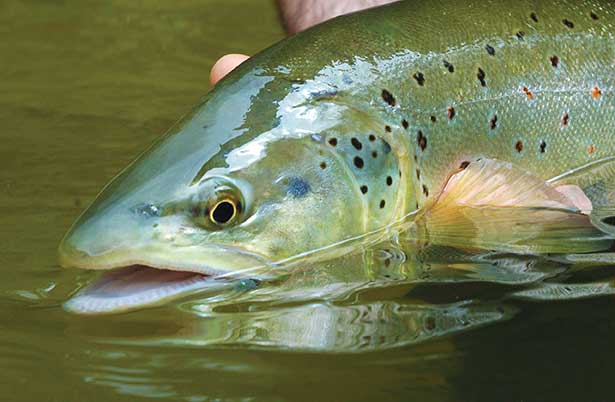A big wild brown trout is a cagey adversary, with behaviors that don’t play to the traditional methods of most trout anglers. With conventional tackle or fly gear, the techniques that catch numbers of trout generally aren’t what it takes to catch a big brown. For this reason, many experienced trout anglers view wild browns longer than 20 inches as the most rewarding, and frustrating, pursuit in the sport.
On a Southeastern mountain river, I was once awestruck when an enormous trout streaked from beneath a submerged ledge to rob the end of my line of a fish I was stripping to hand. It was a stark lesson in the way a trout’s diet changes. At some point in a brown trout’s growth, feeding preferences shift to what a friend once called “large protein packages.” These protein packages can be crayfish, smaller fish, large terrestrial insects and the biggest aquatic invertebrates.
Big baits catch big fish, right? This is true, but it doesn’t necessarily give the angler an advantage. Larger meals mean carnivorous browns can sustain growth without feeding predictably or often. They become loners, hunkering down under an undercut bank or ledge and coming out only occasionally to feed, generally in low-light conditions and many times in high water. It is a situation in which the trout is only vulnerable when conditions are toughest on the angler.
There is, however, an exception. It occurs each fall when brown trout go on the move. Between the time the leaves change and when the trees become bare, browns run upstream in search of suitable areas to make their spawning beds, called redds. Whether it’s a large tailwater or a mountain stream, they are looking for the same thing, a gravel bottom with appropriate water conditions to make more trout.
Browns feed more aggressively when they are expending energy to spawn. Ethical anglers the world over disdain the practice of harassing trout on a redd. But these fish are fair game when on the move. Fall offers the best chance of catching a brown trout better than 20 inches in any flow that holds them. The following destinations are a sampling of some of the best in the country.
White River, Arkansas: The tailwaters of Arkansas’ White River have gained a reputation for producing some of the largest carnivorous trout anywhere. Nowhere does the “big bait, big fish” cliché ring truer.
Driftless Region, Iowa: In northeast Iowa, a preponderance of spring seeps creates one of the best trout fishing resources in the country. These are smaller, more intimate streams, but some of them hold big wild browns.
Deerfield River, Massachusetts: There are five dams and 76 miles of the Deerfield River from southern Vermont through Massachusetts to the Connecticut River. Big tailwater conditions grow trout to double-digit weights.
Madison River, Montana: The Madison is the picture of a big Western freestone. It has the big pools and pocket water fly anglers dream of. It also has some big hook-jawed browns.
South Holston River, Tennessee: The SoHo is one of the Southeast’s most famed tailwaters. Browns longer than your arm show up regularly for anglers who can eschew the numbers game and swing for the fences with big fish tactics.
